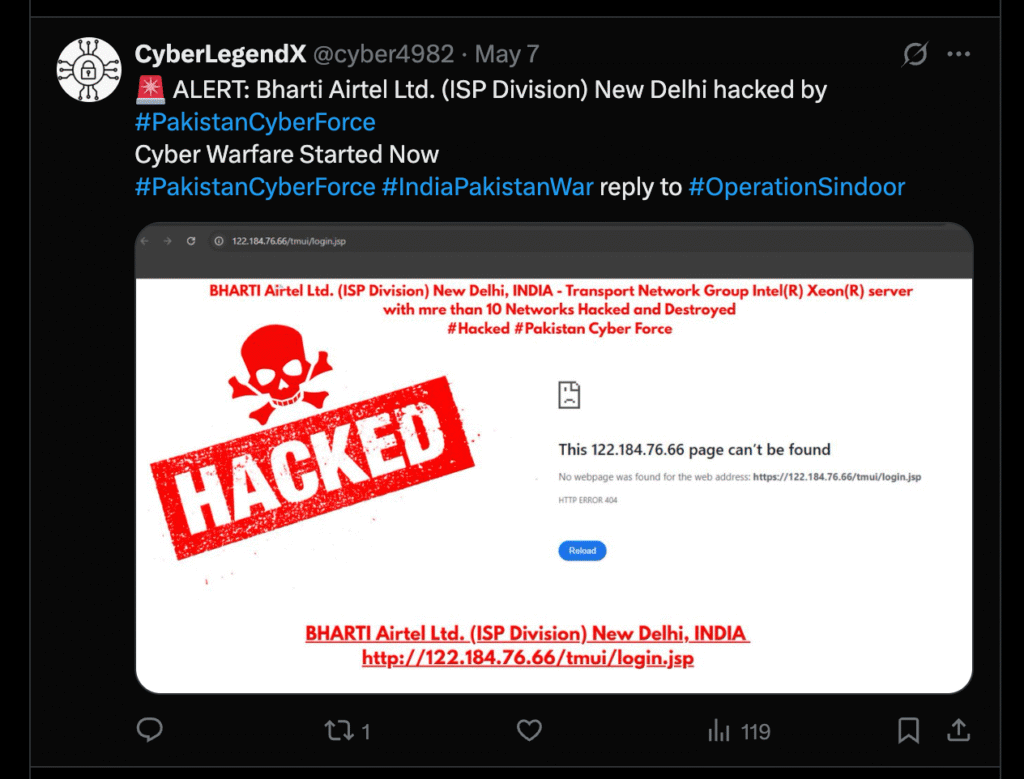In May 2025, a wave of hacktivist activity targeting Indian digital infrastructure sparked widespread alarm in media and social networks, with numerous groups claiming significant breaches of government, educational, and critical infrastructure websites. However, a detailed technical investigation reveals that most of these claims are overstated, with actual impact on Indian cyber assets being minimal. Meanwhile, a persistent and sophisticated espionage threat from the Pakistan-linked APT36 group continues unabated, leveraging advanced malware campaigns to infiltrate sensitive government and defense networks.
Overhyped hacktivist claims vs. tactical reality
Several prominent hacktivist groups – Nation Of Saviors, KAL EGY 319, SYLHET GANG-SG, Electronic Army Special Forces, and Vulture – collectively claimed over 100 successful attacks within a short span. Their targets included high-profile Indian government portals (e.g., CBI, Election Commission of India, NIC), educational institutions, courts, and critical infrastructure such as Indian Railways and financial institutions.
Key findings:
- Data breaches mostly public or fabricated
For instance, the alleged 247 GB breach of the National Informatics Centre (NIC) was disproved after analysis of a 1.5 GB sample showed only publicly available marketing materials and media files. Similarly, a purported breach of the Election Commission of India was a repackaging of a 2023 data leak, not a fresh compromise. - Website defacements and DDoS attacks were short-lived and ineffective
Groups like KAL EGY 319 claimed mass defacements on dozens of educational and medical websites, yet these sites remained operational with no visible defacement. DDoS campaigns against critical government portals, including the Prime Minister’s Office and CERT-In, caused negligible or no downtime, typically lasting less than five minutes-well within the mitigation capacity of standard DDoS defenses. - Leaked judicial data mostly public metadata with some password hash exposure
SYLHET GANG-SG’s claim of accessing 1 million Andhra Pradesh High Court case details was found to involve mostly publicly accessible case metadata. Although some password hashes were leaked, the overall sensitivity of the data was overstated. - Fabricated indian army data leak
A claimed leak of Indian Army personnel data by Team Azrael was found to contain inconsistent and likely fabricated information, with no credible link to actual military or intelligence operatives.
Social media amplification and disinformation
Pakistan-linked Twitter accounts such as P@kistanCyberForce, CyberLegendX, and others have been actively amplifying these hacktivist claims, often without verification. They portray the cyberattacks as part of a broader India-Pakistan digital conflict, sometimes referencing operations like “Operation Sindoor” and “OPERATION BUNYAN AL MARSOUS.” These narratives emphasize surveillance and strategic restraint rather than overt disruption, aiming to project advanced cyber capabilities.
The real espionage threat: APT36 and Crimson RAT
While hacktivist activities remain largely nuisance-level, the Advanced Persistent Threat (APT) group APT36 continues to pose a serious and ongoing threat to Indian national security.
Crimson RAT malware campaign
APT36’s signature tool, Crimson RAT, is a sophisticated .NET-based Remote Access Trojan designed for stealthy espionage. In a recent campaign exploiting the emotional aftermath of the April 2025 Pahalgam terror attack, APT36 deployed a multi-vector phishing operation targeting government and defense personnel.
- Delivery mechanisms:
- Malicious PowerPoint add-on files (.ppam) containing macros disguised as official reports.
- PDFs embedding links to spoofed login portals mimicking official Jammu & Kashmir Police websites for credential harvesting.
- Spoofed domains infrastructure:
Domains such asiaf.nic.in.ministryofdefenceindia.organdindianarmy.nic.in.departmentofdefence.dewere used to host phishing pages and malware payloads, hosted by providers like Alexhost Srl and Shinjiru Technology. - Malware execution and capabilities:
The RAT payload masquerades as an image file (e.g., WEISTT.jpg), which upon execution launches an executable (e.g., jnmxrvt hcsm.exe) that connects to a hardcoded C2 server (IP: 93.127.133.58, port 1097). Crimson RAT supports over 20 commands including screenshot capture, file listing and exfiltration, persistent installation, and remote code execution, enabling comprehensive espionage operations.
Implications for cybersecurity professionals
- Hacktivist activity remains low-level and largely overstated
Organizations should maintain standard cyber hygiene, including robust DDoS mitigation and patching known vulnerabilities, to counter these nuisance attacks. - Focus on detecting and mitigating APT threats
The real danger lies in targeted, well-resourced APT campaigns like those from APT36. Security teams must prioritize detection of phishing attempts, especially those leveraging social engineering tied to current events, and monitor for indicators of compromise related to Crimson RAT. - Verification and attribution are critical
Analysts must rigorously verify breach claims and leaked data before drawing conclusions or escalating alerts, as misinformation and recycled data are common in geopolitical cyber conflicts.
The recent surge in India-Pakistan hacktivist claims is largely a theatrical display with limited tactical impact. However, beneath the noise, APT36’s Crimson RAT campaigns represent a sophisticated and ongoing espionage threat demanding vigilant cybersecurity defenses. For experts in the field, discerning the difference between low-level hacktivism and high-stakes cyber espionage is crucial for informed threat response and strategic resource allocation.
